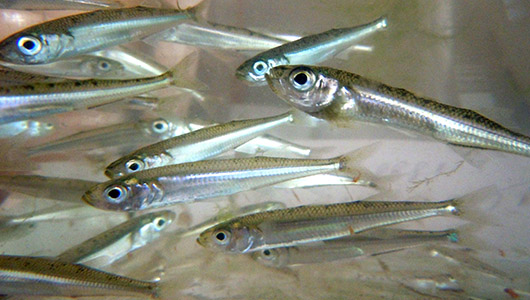The San Francisco Bay-Delta estuary supports a diverse array of native aquatic plant and animal species, including Chinook salmon, sturgeon, smelt, steelhead and other native fishes that depend on freshwater flow from our rivers into the estuary. However, 150 years of altering the estuary by reducing natural flows and destroying wetland and floodplain habitats have devastated these species.

The Delta smelt is a fish found nowhere else in the world. Protections for the smelt benefit other fish and wildlife species, including Chinook salmon and steelhead. Photo by Joel Williams
By Mallory Johnson
Published: April, 2015
The San Francisco Bay-Delta estuary supports a diverse array of native aquatic plant and animal species, including Chinook salmon, sturgeon, smelt, steelhead and other native fishes that depend on freshwater flow from our rivers into the estuary. However, 150 years of altering the estuary by reducing natural flows and destroying wetland and floodplain habitats have devastated these species. The recent drought has only made a bad situation worse.
Results from the latest fish population survey, posted last month by the California Department of Fish and Wildlife, confirmed that Delta smelt are closer to extinction than ever before. Once among the most abundant resident fish in the estuary, Delta smelt are now at an all-time low. The rapid loss of this species—found nowhere else in the world—is an indication of the failing health of the entire Bay-Delta estuary.
Last month, the Bay Institute launched Countdown to Extinction, a campaign to draw attention to the increasing likelihood that we could lose a number of fish species native to the San Francisco Bay-Delta estuary in 2015. Countdown to Extinction calls out the March through May timeframe as an ecologically critical period for many species that rely on adequate spring freshwater flows from Central Valley rivers and the estuary to survive and flourish.
Why is the Countdown to Extinction important?
The State of California is required under federal and state law to set and enforce water quality standards for the Bay-Delta estuary. Those standards are specifically designed to share water appropriately between environmental and human use in wet and dry years. However, due to the extreme drought, the state has suspended the requirement for water flows to the Bay during the month of March—flows that are critical for native fish species to survive.
One reason for this is to keep enough cold water in storage to protect salmon habitat in the Sacramento River. However, this was also the reason given for suspending Bay inflows last year, which nevertheless resulted in the loss of 95 percent of the 2014 class of the endangered winter-run Chinook salmon, as well as record or near-record population lows for Delta smelt, longfin and flounder. Suspending the rules when many of our native fish are listed as endangered is likely to lead to extinction for one or more of our native species and cause permanent changes to the Bay ecosystem.
We are now facing the possibility that the state will suspend requirements for Bay inflow in April and May as well. But it’s not too late to reverse this course.
The state can still enforce the existing requirements and provide the necessary flows through the spring months. This is the best—and only—option available in 2015 to preserve and protect the Delta smelt and other estuarine species that depend on adequate freshwater flows. The Countdown to Extinction campaign hopes that public awareness and action will motivate decision-makers to enforce the protections and restore the water flows so critical for the survival of these fish species.
For more information and regular campaign updates, follow the Bay Institute’s Countdown to Extinction on www.thebayinstitute.org.
Mallory Johnson is the Public Relations Coordinator for Aquarium of the Bay, a nonprofit organization dedicated to protecting, restoring and inspiring the conservation of San Francisco Bay and its watershed.

